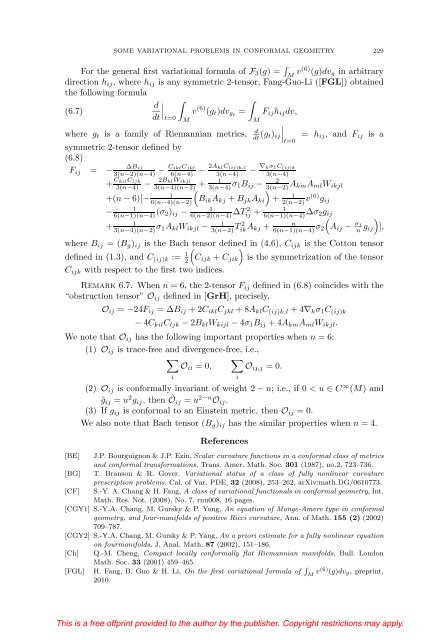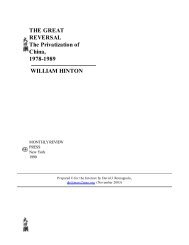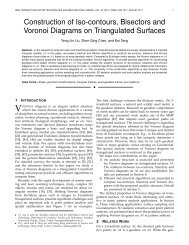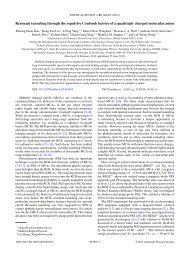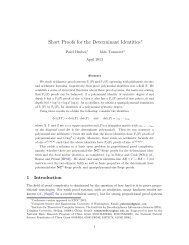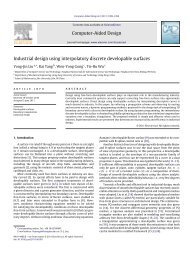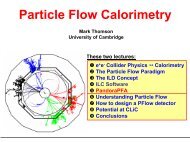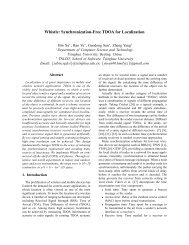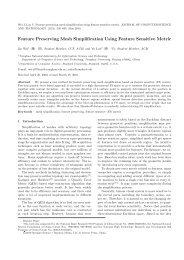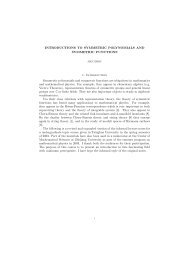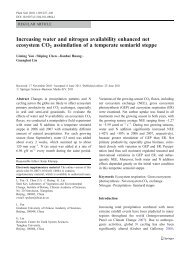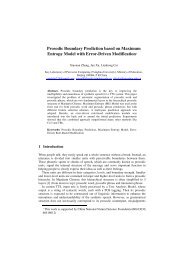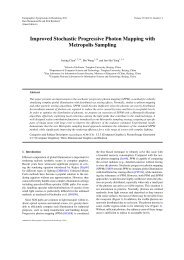Some variational problems in conformal geometry
Some variational problems in conformal geometry
Some variational problems in conformal geometry
You also want an ePaper? Increase the reach of your titles
YUMPU automatically turns print PDFs into web optimized ePapers that Google loves.
SOME VARIATIONAL PROBLEMS IN CONFORMAL GEOMETRY 229<br />
For the general first <strong>variational</strong> formula of F 3 (g) = ∫ M v(6) (g)dv g <strong>in</strong> arbitrary<br />
direction h ij ,whereh ij is any symmetric 2-tensor, Fang-Guo-Li ([FGL]) obta<strong>in</strong>ed<br />
the follow<strong>in</strong>g formula<br />
d<br />
∫<br />
∫<br />
(6.7)<br />
∣ v (6) (g t )dv gt = F ij h ij dv,<br />
dt t=0<br />
M<br />
∣<br />
d<br />
where g t is a family of Riemannian metrics,<br />
dt (g ∣∣t=0<br />
t) ij<br />
symmetric 2-tensor def<strong>in</strong>ed by<br />
= h ij , and F ij is a<br />
(6.8)<br />
F ij = − ΔB ij<br />
3(n−2)(n−4) − C iklC jkl<br />
6(n−4)<br />
− 2A klC (ij)k,l<br />
3(n−4)<br />
− ∇ kσ 1 C (ij)k<br />
3(n−4)<br />
+ C kilC ljk<br />
3(n−4) − 2B klW ikjl<br />
3(n−4)(n−2) + 1<br />
3(n−4) σ 1B ij − 2<br />
3(n−2) A kmA ml W ikjl<br />
+(n − 6)[−<br />
1<br />
6(n−4)(n−2)<br />
M<br />
(B ik A kj + B jk A ki<br />
)<br />
−<br />
1<br />
6(n−1)(n−4) (σ 2) ij −<br />
1<br />
6(n−2)(n−4) ΔT 2 ij + 1<br />
+ 1<br />
2(n−2) v(6) g ij<br />
6(n−1)(n−4) Δσ 2g<br />
( ij<br />
1<br />
+<br />
3(n−4)(n−2) σ 1A kl W ikjl − 1<br />
3(n−2) T ik 2 A n<br />
kj +<br />
6(n−1)(n−4) σ 2 A ij − σ 1<br />
n<br />
g ij<br />
)],<br />
where B ij =(B g ) ij is the Bach tensor def<strong>in</strong>ed<br />
)<br />
<strong>in</strong> (4.6), C ijk is the Cotton tensor<br />
def<strong>in</strong>ed <strong>in</strong> (1.3), and C (ij)k := 1 2<br />
(C ijk + C jik is the symmetrization of the tensor<br />
C ijk with respect to the first two <strong>in</strong>dices.<br />
Remark 6.7. When n = 6, the 2-tensor F ij def<strong>in</strong>ed <strong>in</strong> (6.8) co<strong>in</strong>cides with the<br />
“obstruction tensor” O ij def<strong>in</strong>ed <strong>in</strong> [GrH], precisely,<br />
O ij = −24F ij =ΔB ij +2C ikl C jkl +8A kl C (ij)k,l +4∇ k σ 1 C (ij)k<br />
− 4C kil C ljk − 2B kl W kijl − 4σ 1 B ij +4A km A ml W ikjl .<br />
We note that O ij has the follow<strong>in</strong>g important properties when n =6:<br />
(1) O ij is trace-free and divergence-free, i.e.,<br />
∑<br />
∑<br />
O ii =0, O ij,j =0.<br />
i<br />
(2) O ij is <strong>conformal</strong>ly <strong>in</strong>variant of weight 2 − n; i.e., if 0


